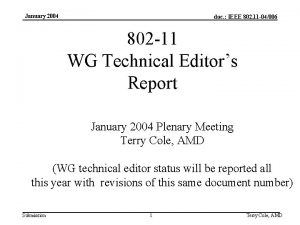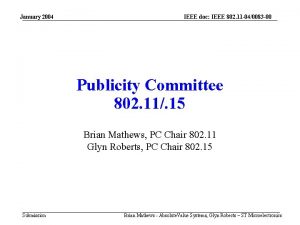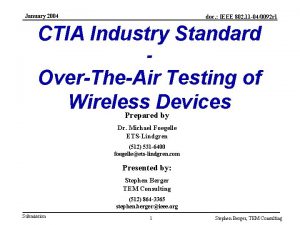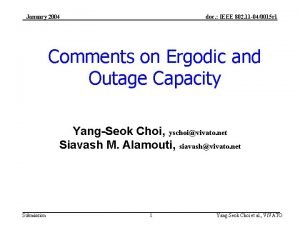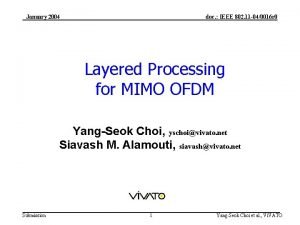January 2004 doc IEEE 802 11 04106 r








- Slides: 8

January 2004 doc: IEEE 802. 11 -04/106 r 0 STA disassociation behavior Joe Kwak, Marian Rudolf Inter. Digital Submission 1 Joe Kwak, Inter. Digital

January 2004 doc: IEEE 802. 11 -04/106 r 0 Disassociation behavior as mandated in current specification 5. 4. 2. 4 Disassociation The disassociation service is invoked whenever an existing association is to be terminated. Disassociation is a DSS. In an ESS, this tells the DS to void existing association information. Attempts to send messages via the DS to a disassociated STA will be unsuccessful. The disassociation service may be invoked by either party to an association (non-AP STA or AP). Disassociation is a notification, not a request. Disassociation cannot be refused by either party to the association. APs may need to disassociate STAs to enable the AP to be removed from a network for service or for other reasons. STAs shall attempt to disassociate whenever they leave a network. However, the MAC protocol does not depend on STAs invoking the disassociation service. (MAC management is designed to accommodate loss of an associated STA. ) Submission 2 Joe Kwak, Inter. Digital

January 2004 doc: IEEE 802. 11 -04/106 r 0 Disassociation behavior in practice …refering to last paragraph (highlight in red): = “STA may or may not send a DISASSOCIATION frame to the AP when leaving a network, for example at power-down” n Current STA implementations w. r. t disassociation behavior in “normal”, non-pathologic situations vary widely, some try, most do not even try Submission 3 Joe Kwak, Inter. Digital

January 2004 doc: IEEE 802. 11 -04/106 r 0 Why is this a problem ? n n Currently, most STAs passively “disappear” and AP experiences large uncertainty w. r. t. STAs still camping in the BSS The knowledge of how many STAs are currently associated / authenticated, i. e. “in the system” is key to any form of load and admission control in the. 11 network Use of activity-based time-out counters not good enough for RRM and network management purposes, it is also a security threat But in 11 k, we can provide this kind of indication to the AP, an extremely valuable information to the network Submission 4 Joe Kwak, Inter. Digital

January 2004 doc: IEEE 802. 11 -04/106 r 0 Proposal n n n We suggest to make sending the DISASSOCIATION frame mandatory when STAs leave a network in the sense of the current paragraph 5. 4. 2. 4 The idea is to capture the “ 99%” of STAs leaving a BSS in controlled manner (power down or switching off etc. ), but not to account for all thinkable pathologic cases (STA falling into the bath-tube or PCMCIA card extracted, etc) Our proposal for the way to capture this behavior in the specs: write this into the PICS, and strengthen the requirement wording. Submission 5 Joe Kwak, Inter. Digital

January 2004 doc: IEEE 802. 11 -04/106 r 0 Strengthen Disassociation Behavior Wording 5. 4. 2. 4 Disassociation The disassociation service is invoked whenever an existing association is to be terminated. Disassociation is a DSS. In an ESS, this tells the DS to void existing association information. Attempts to send messages via the DS to a disassociated STA will be unsuccessful. The disassociation service may be invoked by either party to an association (non-AP STA or AP). Disassociation is a notification, not a request. Disassociation cannot be refused by either party to the association. APs may need to disassociate STAs to enable the AP to be removed from a network for service or for other reasons. STAs shall attempt to disassociate whenever they leave a network, power down or become incapable of continuing network service. However, the MAC protocol does not depend on STAs invoking the disassociation service. (MAC management is designed to accommodate loss of an associated STA. ) Submission 6 Joe Kwak, Inter. Digital

January 2004 doc: IEEE 802. 11 -04/106 r 0 Proposed PICS Element Submission 7 Joe Kwak, Inter. Digital

January 2004 doc: IEEE 802. 11 -04/106 r 0 Motion for Disassociate normative text n n n n Move to instruct the editor to incorporate text from document 11 -04 -0105 -00 -000 k-Shall_Disassociate. doc into next TGk draft specification document Moved by Joe Kwak Seconded by: ________ Vote YEA _______ Vote NEA _______ ABSTAIN _______ Vote Passes/Fails at ___% Submission 8 Joe Kwak, Inter. Digital









